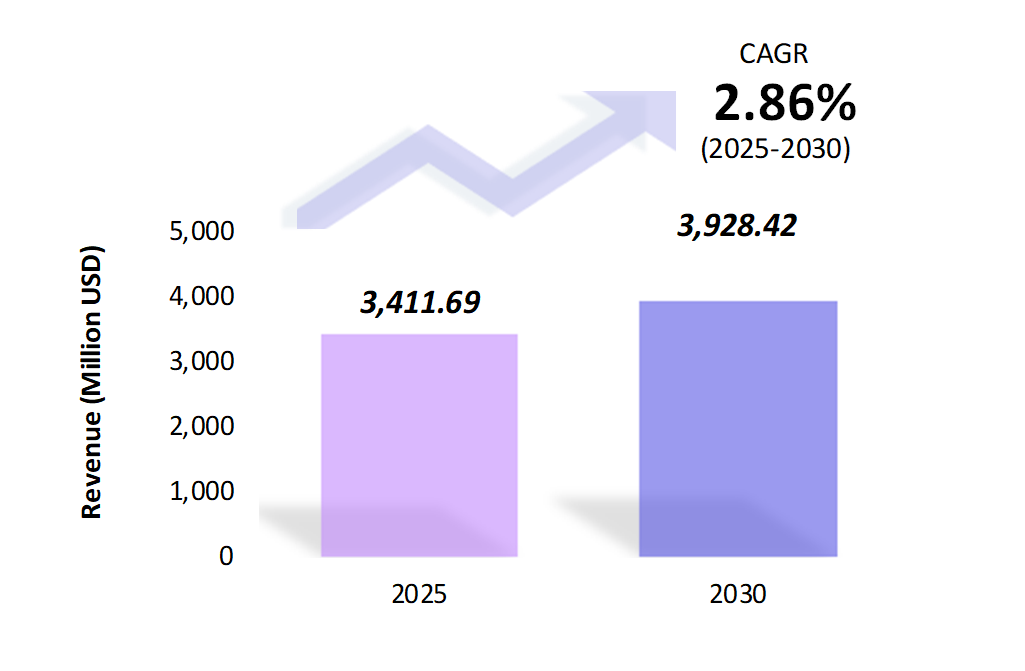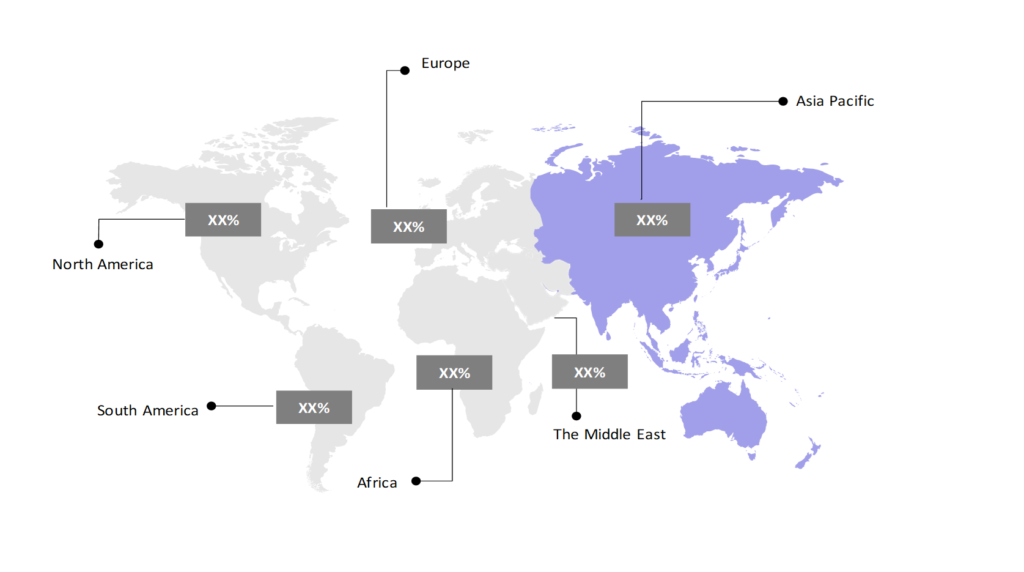Soap Noodles Market: Size, Share, Trends & Forecast (2024-2029)
The market report offers a detailed analysis segmented by Source (Vegetable Oil, Tallow); by Application (Households, Special Purpose Soaps, Industrial Uses); by Geography (North America, South America, Asia Pacific, Europe, The Middle East, Africa).
Outlook

- The soap noodles market is estimated to be at USD 3,411.69 Mn in 2025 and is anticipated to reach USD 3,928.42 Mn in 2030.
- The soap noodles market is registering a CAGR of 2.86% during the forecast period 2025-2030.
- The soap noodles market, essential for soap manufacturing, offers customizable ingredients for various soap products. Made from saponified oils and fats, these noodles come in vegetable and animal-based varieties.
Request a free sample.
Ecosystem

- The participants in the global soap noodles industry are leaders in producing both animal-fat-based and vegetable-oil-based soap noodles, often focused on regional markets where their raw materials are sourced.
- These companies are increasingly investing in sustainable practices to meet regulatory requirements and consumer expectations, along with partnerships between soap noodle producers and cosmetic companies to expand market reach.
- Several important entities in the soap noodles market include Olivia Oleo Pte Ltd.; IOI Corp. Berhad; Kerawalla Group; Musim Mas Group; KLK Oleo; and others.
Ask for customization.
Findings
| Attributes | Values |
|---|---|
| Historical Period | 2019-2023 |
| Base Year | 2024 |
| Forecast Period | 2025-2030 |
| Market Size (2025) | USD 3,411.69 Mn |
| Market Size (2030) | USD 3,928.42 Mn |
| Growth Rate | 2.86% CAGR from 2025 to 2030 |
| Key Segments | Source (Vegetable Oil, Tallow); Application (Households, Special Purpose Soaps, Industrial Uses); Geography (North America, South America, Asia Pacific, Europe, The Middle East, Africa) |
| Key Vendors | Olivia Oleo Pte Ltd.; IOI Corp. Berhad; Kerawalla Group; Musim Mas Group; KLK Group |
| Key Countries | The US; Canada; Mexico; Brazil; Argentina; Panama; China; India; Indonesia; South Korea; The UK; Germany; France; Turkey; UAE; Saudi Arabia; Ethiopia; South Africa |
| Largest Market | Asia Pacific |
Get a free quote.
Trends
- Customization for Specialty Soaps: The market features soap noodle formulations for medicated, moisturizing, and organic soap varieties. Manufacturers create specialized blends that address specific skincare needs, from acne treatment to sensitive skin products.
- Increased Use of Organic and Natural Ingredients: The trend toward organic ingredients has led manufacturers to integrate natural oils and botanicals in soap noodles. These modifications cater to consumers seeking products free from synthetic additives and chemicals. For instance, companies like Stephenson Personal Care now offer organic-certified soap noodles made from all-natural ingredients, appealing to the organic personal care segment.
- Shift Toward Plant-Based and Sustainable Raw Materials: There is an increasing shift toward vegetable oil-based soap noodles, particularly those derived from sustainable palm oil and coconut oil. This trend aligns with consumer preference for eco-friendly products and drives companies to source RSPO (Roundtable on Sustainable Palm Oil) certified oils.
Speak to analyst.
Catalysts
- Increasing Demand for Personal Hygiene Products: Heightened awareness of personal hygiene post-pandemic has boosted the demand for soap products globally, creating robust growth in the soap noodles market. This expansion is further amplified by rising cleanliness standards across developing economies.
- Expanding Industrial Soap Applications: Soap noodles are increasingly used in industrial applications such as detergent bars for cleaning and laundry, especially in price-sensitive regions like Africa and Southeast Asia, where these products offer an affordable alternative to liquid soaps. For instance, Unilever expanded its range of soap noodle-based industrial cleaning products to meet growing demand across Africa.
- Growth of Personal Care Market: With a rise in consumers preferring organic and natural products, the demand for soap noodles derived from organic oils or containing natural additives has surged, especially in North America and Europe. For instance, Stephenson Personal Care offers soap noodles made from natural ingredients, catering to organic beauty and personal care brands across Europe.
Inquire before buying.
Restraints
- Stringent Regulatory and Certification Requirements: Compliance with environmental and safety regulations for ingredients, especially in markets like the EU, can be complex and costly. Regulatory certification for organic or sustainable soap noodles can also increase production costs.
- Environmental Concerns Over Palm Oil Sourcing: The environmental impact of palm oil production, including deforestation and loss of biodiversity, remains a significant challenge for the soap noodles industry. As a key ingredient, unsustainable palm oil practices can impact the industry’s reputation and consumer demand.
- Price Fluctuations of Raw Materials: Prices of key raw materials, like palm oil and coconut oil, are volatile due to global supply-demand imbalances, impacting the production costs of soap noodles. Manufacturers are thus vulnerable to price fluctuations, which can strain profit margins.
Personalize this research.
Hotspot

Explore purchase options.
Table of Contents
| 1. Introduction 1.1. Research Methodology 1.2. Scope of the Study 2. Market Overview / Executive Summary 2.1. Global Soap Noodles Market (2019 – 2023) 2.2. Global Soap Noodles Market (2024 – 2030) 3. Market Segmentation 3.1. Global Soap Noodles Market by Source 3.1.1. Vegetable Oil 3.1.2. Tallow 3.2. Global Soap Noodles Market by Application 3.2.1. Households 3.2.2. Special Purpose Soaps 3.2.3. Industrial Uses 4. Regional Segmentation 4.1. North America 4.1.1. The US 4.1.2. Canada 4.1.3. Mexico 4.2. South America 4.2.1. Brazil 4.2.2. Argentina 4.2.3. Panama 4.2.4. Rest of South America 4.3. Asia Pacific 4.3.1. China 4.3.2. India 4.3.3. Indonesia 4.3.4. South Korea 4.3.5. Rest of Asia Pacific 4.4. Europe 4.4.1. The UK 4.4.2. Germany 4.4.3. France 4.4.4. Rest of Europe 4.5. The Middle East 4.5.1. Turkey 4.5.2. UAE 4.5.3. Saudi Arabia 4.5.4. Rest of the Middle East 4.6. Africa 4.6.1. Ethiopia 4.6.2. South Africa 4.6.3. Rest of Africa 5. Value Chain Analysis of the Global Soap Noodles Market 6. Porter Five Forces Analysis 6.1. Threats of New Entrants 6.2. Threats of Substitutes 6.3. Bargaining Power of Buyers 6.4. Bargaining Power of Suppliers 6.5. Competition in the Industry 7. Trends, Drivers and Challenges Analysis 7.1. Market Trends 7.1.1. Market Trend 1 7.1.2. Market Trend 2 7.1.3. Market Trend 3 7.2. Market Drivers 7.2.1. Market Driver 1 7.2.2. Market Driver 2 7.2.3. Market Driver 3 7.3. Market Challenges 7.3.1. Market Challenge 1 7.3.2. Market Challenge 2 7.3.3. Market Challenge 3 8. Opportunities Analysis 8.1. Market Opportunity 1 8.2. Market Opportunity 2 8.3. Market Opportunity 3 9. Competitive Landscape 9.1. Olivia Oleo Pte Ltd. 9.2. IOI Corp. Berhad 9.3. Kerawalla Group 9.4. Musim Mas Group 9.5. KLK Group 9.6. Company 6 9.7. Company 7 9.8. Company 8 9.9. Company 9 9.10. Company 10 |
Know the research methodology.
Soap Noodles Market – FAQs
1. What is the current size of the soap noodles market?
Ans. In 2025, the soap noodles market size is USD 3,411.69 Mn.
2. Who are the major vendors in the soap noodles market?
Ans. The major vendors in the soap noodles market are Olivia Oleo Pte Ltd.; IOI Corp. Berhad; Kerawalla Group; Musim Mas Group; KLK Group.
3. Which segments are covered under the soap noodles market segments analysis?
Ans. The soap noodles market report offers in-depth insights into Source, Application, and Geography.
